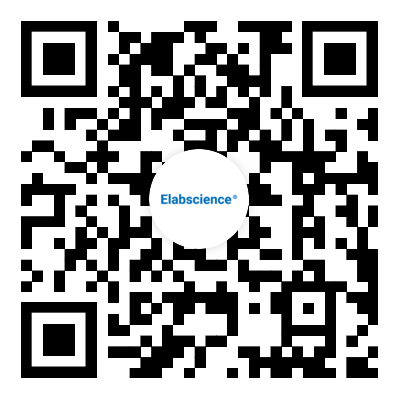Mouse Aβ1-40(Amyloid Beta 1-40) ELISA Kit
中文名称:小鼠β淀粉样蛋白1-40(Aβ1-40)酶联免疫吸附测定试剂盒
Aβ40、Amyloid Beta 40
Price:
- 反应性: Mouse
- 检测范围: 7.81-500 pg/mL
- 灵敏度: 4.69 pg/mL
| 产品应用 | ELISA |
| 检测原理 | 本试剂盒采用双抗体夹心ELISA法。用抗小鼠Aβ1-40抗体包被于酶标板上,实验时样品(或标准品)中的小鼠Aβ1-40会与包被抗体结合。后依次加入生物素化的抗小鼠Aβ1-40抗体和辣根过氧化物酶标记的亲和素,抗小鼠Aβ1-40抗体与结合在包被抗体上的小鼠Aβ1-40结合,生物素与亲和素特异性结合而形成免疫复合物,游离的成分被洗去。加入显色底物(TMB),TMB在辣根过氧化物酶的催化下呈现蓝色,加终止液后变成黄色。用酶标仪在450 nm波长处测OD值,Aβ1-40浓度与OD450值之间呈正比,通过绘制标准曲线计算出样品中Aβ1-40的浓度。 |
| 反应类型 | Sandwich-ELISA |
| 规格 |
96T
/ 48T
/ 96T*5
|
| 反应时间 | 3.5h |
| 反应性 | Mouse |
| 检测方法 | Colormetric |
| 检测范围 | 7.81-500 pg/mL |
| 灵敏度 | 4.69 pg/mL |
| 样本体积 | 100μL |
| 样本类型 | 血清、血浆或其他生物体液 |
| 特异性 | 可检测样本中的小鼠Aβ1-40,且与其它类似物无明显交叉反应 |
| 精密度 | 板内,板间变异系数均<10% |
| 回收率 | 80%-120% |
| 储存条件 | 2-8℃/-20℃ |
| 数据处理 |
-
Activation of PPARA-mediated autophagy reduces Alzheimer disease-like pathology and cognitive decline in a murine model
IF: 11.059 -
Chk1 Inhibition Ameliorates Alzheimer’s Disease Pathogenesis and Cognitive Dysfunction Through CIP2A/PP2A Signaling
IF: 7.62Journal:Neurotherapeutics -
Apicidin attenuates memory deficits by reducing the Aβ load in APP/PS1 mice
IF: 7.035Journal:CNS Neuroscience & Therapeutics -
Cornuside Is a Potential Agent against Alzheimer’s Disease via Orchestration of Reactive Astrocytes
IF: 6.706Journal:Nutrients -
Moringa Oleifera Alleviates Aβ Burden and Improves Synaptic Plasticity and Cognitive Impairments in APP/PS1 Mice
IF: 6.706Journal:Nutrients -
3, 14, 19-Triacetyl Andrographolide alleviates the cognitive dysfunction of 3 × Tg-AD mice by inducing initiation and promoting degradation process of autophagy
IF: 6.388Journal:PHYTOTHERAPY RESEARCHDOI:10.1002/ptr.7619 -
AP2S1 regulates APP degradation through late endosome-lysosome fusion in cells and APP/PS1 mice
IF: 6.144Journal:TRAFFIC -
Agomelatine Prevents Amyloid Plaque Deposition, Tau Phosphorylation, and Neuroinflammation in APP/PS1 Mice
IF: 5.75Journal:Frontiers in Aging Neuroscience -
Platelets transport β-amyloid from the peripheral blood into the brain by destroying the blood-brain barrier to accelerate the process of Alzheimer's disease in mouse models
IF: 5.682 -
Sulforaphane inhibits the production of Aβ partially through the activation of Nrf2-regulated oxidative stress
IF: 5.396
Q1:What is the difference between (Aβ1-40) and (Aβ1-42)?
In mammals, the APP gene is located on chromosome 21 and has a total of 8 subtypes, whose subtypes generally contain 365~770 amino acid residues. The most common are APP695, APP751, and APP770, of which APP695 is highly expressed in the central nervous system. APP is a type I transmembrane glycoprotein with a molecular weight of about 110~130 kDa, with a large extracellular (amino terminal) domain and a small cytoplasmic tail region (intracellular carboxyl terminal). APP is metabolized mainly through two pathways: amyloid (β) pathway and non-amyloid (α) pathway. The amyloid pathway is that APP is cleaved by β-secretase into sAPPβ and a C-terminal fragment containing 99 amino acids. The latter is further cleaved by γ-secreting enzymes into Aβ and ACID, and the Aβ generated by this pathway accounts for 90% to 95% of the total Aβ, including two types of Aβ1-40 and Aβ1-42, of which the content of Aβ1-40 is higher, but Aβ1-42 has A strong hydrophobic effect, its toxicity is greater, and it is easy to polymerization. These Aβ fragments accumulate in mitochondria, lysosomes, and the endoplasmic reticulum, causing these suborganelles to malfunction. In the non-starchy source pathway based on alpha secretase, the alpha secretase cuts APP into sAPP and a C-terminal fragment containing 83 amino acids, which is then cut by gamma secretase to produce P3 and ACID, but these small fragments are cleared by neurons. The mutation of APP gene can cause abnormal protein expression or hydrolysis change, thus affecting the content and composition of Aβ in cells. Aβ mainly exists in the brain in the form of Aβ40 and Aβ42, and the content of Aβ42 is low (< 10%), but easy to aggregate, and then fibrosis and deposition, thus forming a diffuse senile plaque, which is also one of the main pathological characteristics of AD. Moreover, Aβ produced by APP after cleavage by β- and γ-secretory enzymes on the cell membrane can cause oxidative stress, calcium ion inflow, and then damage mitochondria, leading to nerve cell disorders, activation of apoptosis-related proteins and factors, and finally start the apoptosis process of cells. In addition, Aβ can also indirectly cause neuronal apoptosis by causing inflammation in the brain and neurofibrillary tangles, which is an important reason for the formation and development of AD.










